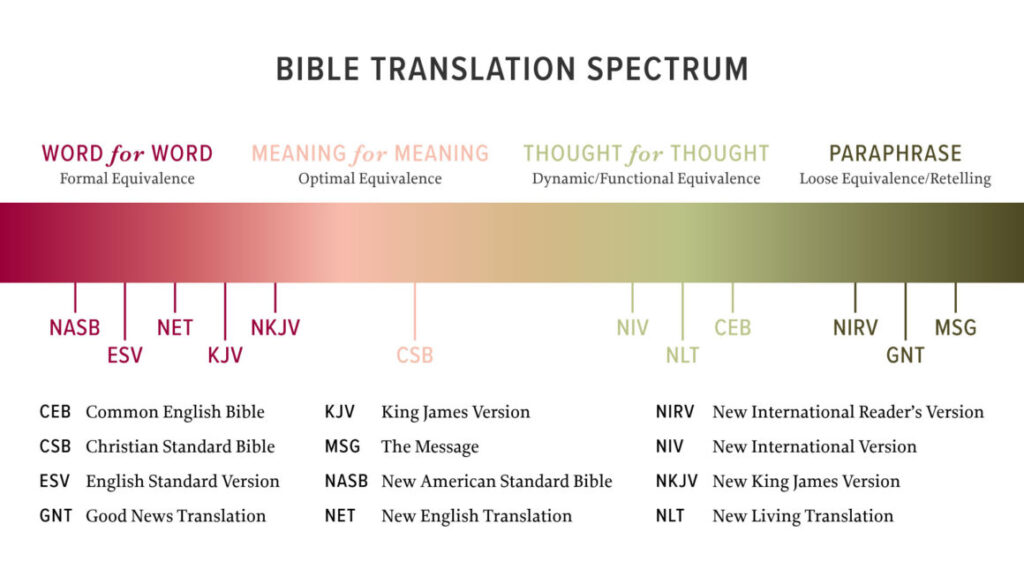Did you know that even in English there are many different Bible translations? Having access to countless English translations of the Bible is an enormous privilege. There are people all over the world who don’t even have a single translation of the Bible in their language.
But while we acknowledge that privilege, it is also true that it can be overwhelming to decide which translation we want to use in our personal use and study. If you’re starting to take the spiritual disciplines seriously, this is likely a question that has come up for you.
So let’s break down the differences between them to help us answer that question!
The Fundamentals of Bible Translations
The Bible was originally written in Hebrew, Greek, and a little bit of Aramaic. Therefore, every single English Bible is a translation from the original languages. This is a good thing- this means that people in those languages can read the Bible in their own language.
There are different approaches taken for the various translations around many different factors: context, culture, tense, voice, and parts of speech.
The three main translation philosophies are Formal Equivalent Translations, Dynamic Equivalent Translations, and Paraphrase Translations. There are also what are considered Optimal Equivalent Translations.
Check out this spectrum graph to help you visualize the different philosophies:

Let’s break all of those down!
Formal Equivalent Translations
These translations are word-for-word and prioritize the literal accuracy of the original languages. The goal is to stay as similar to the original text as possible (preserving lexical details, grammatical structure, vocabulary, and syntax). The downside is these can sometimes be clunkier to read and not as easily readable. Sometimes the context and general idea of the passage can get lost.
Some Formal Equivalent Translations include the NASB (New American Standard Bible) and ESV (English Standard Version).
Dynamic Equivalent Translations
These translations are thought-for-thought and prioritize readability. In this translation philosophy, the target audience is taken into account. The goal is to preserve the response of the reader. AKA, the goal is for a modern-day reader to respond in the same way the original reader of the Hebrew/Greek text would have.
The NIV (New International Version) and the NLT (New Living Translation) are examples of these translations.
Paraphrase “Translations”
We wouldn’t even really call this a translation per se, but beyond “thought-for-thought” on the spectrum are paraphrases. It’s kind of like a No-Fear Shakespeare version of Shakespeare.
The Message is the most popular paraphrase out there right now.
Optimal Equivalent Translation
These translations are considered “meaning-for-meaning.” They pursue both linguistic precision to the original languages and readability.
The CSB (Christian Standard Bible) is a prime example.
So, Which Translation Should I Use?
We personally use ESV most often, but we like reading CSB as a supplement to our studies.
The goal of each Bible translation is to present and deliver God’s Word in a way that is both accurate and easy to understand by the reader.
What translation you are drawn to may depend on what you are using it for or what context you’re in. If you’re preparing an exegetical teaching, a more word-for-word translation, such as ESV may be the way to go.
Or, if you’re reading for fun or in longer chunks, a more thought-for-thought translation, such as NIV or NLT may be ideal.
A lot of times when I’m (Nathaniel) deep in a study, I’ll pull out a few different translations to get a more well-rounded understanding of a text.
Ultimately there’s not a huge difference between most translations (since they are all translating the same original texts), so finding one you like and just being consistent to read it is the ultimate goal.
One Degree Shift
Find a translation that you feel is the best for you and read it!
Want to Stay a Little Longer?
- Listen to these other episodes on reading your Bible consistently, Bible study tips for beginners, and why you should study theology.
- Download this guide to get started on going deeper into reading your Bible!
- Subscribe to our weekly newsletter! We deliver one theological thought (among other things), once a week
- Follow along on Instagram for even more education, news, and fun!

+ show Comments
- Hide Comments
add a comment